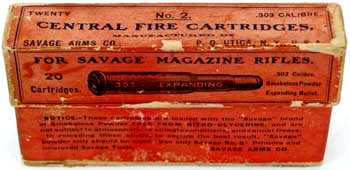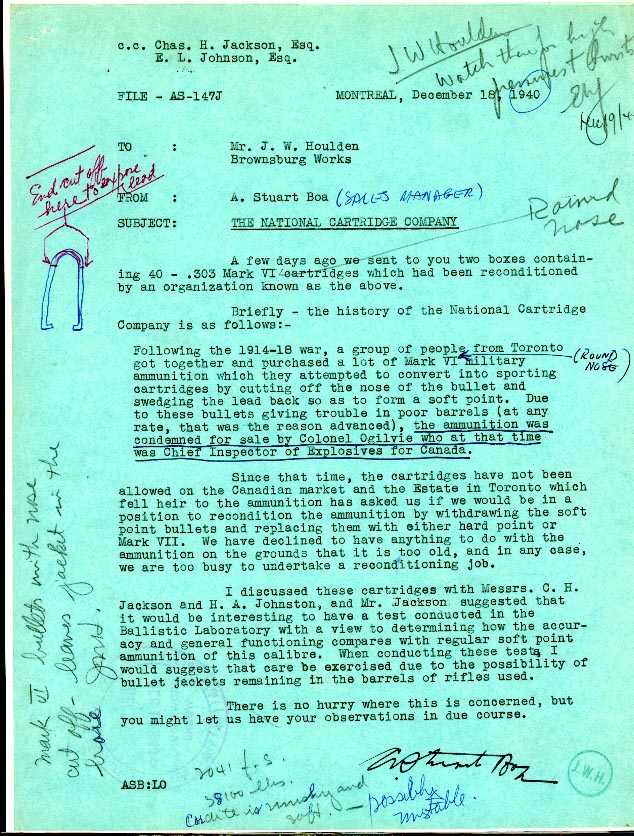|
THE CARTRIDGE COLLECTOR'S EXCHANGE |
| Contents
Cartridge
Lists
Prior Picture Pages:
Links to Other Sites
Cartridge Collectors Organizations:
Auctions:
Books:
Other Collector's Sites: |
Home of the Old Ammo Guy's Virtual
Cartridge Trading Table Featuring a wide range of antique, obsolete, and modern ammunition for collectors Picture Page July 2008 Those numbered Savage .303 loads............
I spotted this worn Savage Arms Company .303 box in an auction recently, and didn't recall ever seeing one with the small 'No. 2.' label stuck to the top before. Checking my own box collection, I was surprised to find that I had owned the same box for quite a number of years, but had never gotten around to determining what the 'No. 2 signified. A question posted on the International Ammunition Association's cartridge forum yielded a speedy response, to the effect that from about 1900 to perhaps the early 1920s, Savage assigned a standard number to each of their .303 loads, as follows:
No. 1 is "Regular" - smokeless powder with a full metal patched bullet;
The following is an early Savage ad that addresses four of the loads. . . . . . . . . . .
An addition to the National Cartridge Co saga.....
In September 2003, I included a write-up on my picture page regarding the National Cartridge Company of Toronto, Canada, and their ill-conceived venture that involved converting surplus WW1 military .303 Mark VI cartridges to sporting ammunition by cutting off the jacket at the nose of the bullet and reshaping the exposed lead core to form a soft nose. I recently received a scan of the CIL memorandum that was discussed in the earlier write-up but was not included as a picture at that time as the copy I had was of very poor quality. I have included the new scan below. The notes in the margins expressing the thoughts of those people at CIL whose hands the memo passed through are quite interesting. One even expressed the sentiment that most of us would have - Let's shoot some of it! I have also included one of the cartridges from the box shown above, which has been sectioned and shows the open base design of the bullet that was responsible for the problems that were encountered. Obviously, the person who drew the diagram of the bullet jacket in the left margin was either very familiar with the Mk VI bullet, or had a sectioned bullet handy to refer to, as his drawing is very accurate.
. .
. .
. . . . . . . . . . . . . . . .
. . .
The 15.43mm Prussian needle cartridge......... The German engineer Johann Nikolaus von Dreyse is credited with developing a bolt action rifle in 1835 that became the basis for all of the military bolt action rifles that came along after it. His rifle introduced a number of features that are common to today's bolt action rifles, including: 1. a firing pin, in this case a long, sharp needle, that was actuated by a coil spring to propel it forward against the primer; 2. a bolt handle that was used to open the bolt for loading a cartridge and positioning the firing pin against a trigger-actuated sear with its coil spring fully compressed; and 3. a cam on the side of the action in front of which the handle was rotated to hold the bolt in position against the breech end of the barrel, forming a relatively gas-tight seal for firing.
. . . . . . This picture taken from Ian Hogg's The Illustrated Encyclopedia of Ammunition does an excellent job of illustrating the construction of the Dreyse rifle action and the points discussed above. The Dreyse cartridge could easily be mistaken for one of a number of
variations of the common paper musket cartridge when viewed intact; its
unique characteristics can only be revealed by an x-ray or by disassembling
it. Like earlier musket cartridges, it contains a lead bullet and powder
charge within a paper wrapper, which is twisted and tied over the nose of
the bullet. However, unlike a common musket cartridge, which depends upon a
spark produced by a external flint or percussion cap for
The base of the cartridge consists of a paper disc to which the bottom edges of the wrapper have been glued. This sealing of the base would have been one of the first steps in making the cartridge; the wrapper was wound tightly around a dowel with its lower edge extending a little beyond the end of the dowel. Then the paper disc was positioned against the end of the dowel and the edge of the wrapper was folded over and glued to the disc. When the dowel was removed, the wrapper formed a tube, into which a measured powder charge was poured. Next, the wad and bullet were placed in the mouth of the tube and pushed down against the powder, and the top of the tube was twisted and tied. Excess paper was trimmed off above the tied end, and the cartridge was probably dipped in a solution of wax and some type of solvent to make it waterproof. . . .
|





 ignition,
the Dreyse incorporates the source of ignition within the cartridge, in the
form of a percussion cap centered in a cardboard wad at the base of the
bullet and oriented with its open end towards the base of the cartridge. The
two tone wrapper on the cartridge shown here has resulted from a reaction
with the black powder charge, which has caused the lower portion of the
wrapper that holds the powder to darken. The lighter upper portion contains
the egg-shaped lead bullet and the cardboard wad with its percussion cap.
The cannelure-like indentation around the dark portion of the cartridge is
the result of its having been wired to a display board by its previous
owner.
ignition,
the Dreyse incorporates the source of ignition within the cartridge, in the
form of a percussion cap centered in a cardboard wad at the base of the
bullet and oriented with its open end towards the base of the cartridge. The
two tone wrapper on the cartridge shown here has resulted from a reaction
with the black powder charge, which has caused the lower portion of the
wrapper that holds the powder to darken. The lighter upper portion contains
the egg-shaped lead bullet and the cardboard wad with its percussion cap.
The cannelure-like indentation around the dark portion of the cartridge is
the result of its having been wired to a display board by its previous
owner.